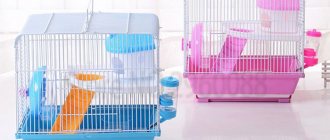Hamsters in the house need to create the right conditions for existence, because the health of the pet and its lifespan depend on this. The first step is to choose a good cage where he will feel cozy and comfortable. When choosing this accessory, the size and breed of the hamster are taken into account.
In the article we will look at the types of cages for Djungarian and Syrian hamsters, what they can be made of, the minimum size, what design is best to choose, what should be in a hamster’s cage and where to put it.
Basic criteria for choosing a cage for a hamster
In order for your hamster to live long and happily in your home, you need to purchase a comfortable cage for him, equipped with everything necessary for normal life. There are two important parameters for choosing a house for a hamster - dimensions and material of the product.
Dimensions
Hamsters are active animals, and due to their natural characteristics, they need a spacious home. The larger the cage, the more comfortable the pet will feel.
The minimum cage size for a hamster is 30x30x45cm, but more is possible. To improve air circulation in the living space, it is recommended to choose a cage whose width is greater than its height.
What else to pay attention to:
- The optimal distance between the cage bars is 0.5 cm.
- A wide door makes it convenient for the owner to put his hand inside to feed food and clean the pet’s home.
- If a 2-story cage is selected, the height of each floor must be at least 25 cm.
- If a cage is purchased for two hamsters, its dimensions should be at least twice as large (60x60x90 cm).
The second floor of the cage must have a full floor so that the pet does not fall and get injured.
Material of manufacture
Hamster cages are made from different materials.
Design features:
- A cage made of metal rods ensures good air circulation. Also, such a home will provide the pet with additional protection from the domestic cat. Cons: food and other debris will spill out of the structure.
- Glass aquariums for hamsters. Pros: spillage of debris from the structure is eliminated; the owner can observe the life of the pet through transparent glass. Disadvantages: it is more difficult to clean inside the home, there is no good air circulation and the hamster breathes ammonia vapor.
- Plastic cages are easy to use, easy to clean and are often equipped with additional accessories to entertain your pet (labyrinths, ladders, etc.). Disadvantages: as a result of mechanical damage, the plastic can be damaged; hamsters often gnaw holes in such cages. When purchasing a structure, pay attention to the quality of the material. Plastic should not emit toxic odors, which can cause serious health problems for your pet.
Additional sections and floors
For an animal, the presence of additional floors does not matter. This is even more interesting to the owner. When choosing a multi-story cage, you should pay special attention to the fact that the distance between floors should be no more than 30 cm and no less than 18 cm.
Second floor of the cage
Preference should be given to a cage in which you can independently set floor levels . And the shelves should be made not of rods, but of solid plastic. Slat floors can cause injury to your pet. And the fact that food and nesting material will fall through it will upset the animal and cause it a lot of inconvenience.
Types of cages for hamsters
The assortment includes a large selection of houses for hamsters. Let's look at the most popular designs.
Types of cells:
- standard lattice made of metal rods;
- small glass terrariums for hamsters;
- two- and three-story structures made of rods and plastic;
- burrow houses with tunnels and labyrinths;
- modular cells;
- combined structures with a plastic body and metal grilles;
- Carrying cages are small in size and are not intended for permanent residence of a pet.
ZOLUX RODY MINI
The cage is made of metal and high-quality plastic. Its dimensions - 21-18*33 cm allow you to install the cage on any tabletop surface. The cage comes with a 75 ml bottle, a wheel, a feeder, 2 flat plugs and another wheel. There is a choice of cage colors on sale, which will allow you to match it to the design of the room. A tall plastic tray will keep the room free of sawdust.
Pros:
- There is a choice of cage color;
- Good equipment;
- Quality materials.
Minuses:
- Suitable for dwarf hamsters only.
Which cage to choose for different breeds
Hamsters are not just rodents of the same type; they differ in breed, size, character traits, shades of fur and lifespan. At home, they mainly keep Dzungarian and Syrian representatives. Let's look at the most convenient designs for keeping hamsters of these two main breeds.
Djungarian hamsters
Djungarian hamsters are medium-sized animals, up to 10 cm in length. The pet's weight is about 65 g. They are nimble and mobile, they love free space and jogging. They often escape from their home.
For such a pet, you need to choose a spacious cage made of durable material with a secure lock. Space is important when equipping a structure; these representatives are of little interest in labyrinths between floors.
The recommended cage for a Djungarian hamster is a one-story structure with a deep tray measuring 30x30x45 cm with horizontal bars on which the pet will happily climb. The distance between the rods is no more than 5 mm, otherwise the hamster may escape from its home. The cage should be equipped with a resting house, a running wheel, as well as a drinking bowl and feeder.
Syrian hamsters
Syrian hamsters are larger in size. Adults reach 12-20 cm in length, and their weight can reach 100-140 g. Accordingly, the cage for such a pet should be large and cozy. The optimal size of the structure is 50x30 cm, height is at least 25 cm. If you purchase a 2-story cage, there must be at least 30 cm between floors.
The Syrian hamster's house should be spacious and equipped with everything necessary for normal life and play - a drinking bowl, feeder, ladders, a wheel, labyrinths, etc. Cramped housing will not allow the hamster to be active, which can cause serious health problems (obesity, physical inactivity, etc.), as well as shorten the life of a hamster.
Cardboard labyrinth
The simplest and most uncomplicated labyrinth. It can be done together with children who will willingly take part in it. For work you will need: a large box, cardboard, non-toxic glue or tape and scissors. The box itself will be the base - the room. Cut strips of arbitrary length from cardboard and stick them in the box so that they form “walls”. The animal will have to go around these walls to get to the treat. Pieces of treats should be placed in several places so that the animal is interested in looking for the “yummy”.
You can improve the labyrinth by adding a second floor to it. This can be done if the box is tall enough. You should not make the tier too high so that the baby does not damage his paws when falling.
Build a staircase to the second floor, this will help the rodent get to the top of the maze.
Such a ladder can be glued to two ledges of a “single-story” structure.
If you combine a homemade structure with a rodent cage, then there will be no additional stress for the animal. He will be able to leave the cage into the labyrinth himself. Otherwise, he must be pulled out and placed in an unfamiliar “scary” environment.
If your cage is connected to such a cardboard structure, the animal must be monitored. The rodent will very quickly figure out that the walls are vulnerable and will make a hole in it. If the parts are connected with tape, it is necessary to monitor the animal so that it does not try the tape too hard. You can glue passages made from toilet paper rolls or paper towels into the labyrinth for dzhungariks.
The cardboard structure requires frequent restoration and is not strong enough. Such a labyrinth can be made from plywood or plastic, which will last longer.
How to set up a cage for a hamster: what should be in the house
In order for a pet hamster to live comfortably in captivity, the house needs to be equipped with various accessories. You can buy them together with the cage or separately in specialized pet stores.
What should be in a hamster's house:
- feeder;
- drinking bowl for water;
- toilet with a special filler that absorbs moisture and odors;
- mineral stone for grinding teeth (a tasty and healthy treat);
- gaming accessories - wheels, tunnels, labyrinths and other complexes for outdoor games.
SAVIC SPELOS XL METRO
The unusual design of the cage for hamsters is presented in the form of a plastic two-tier box. On the second level there is a figured shelf, which has holes for a drinking bowl, wheels and a feeding bowl. The transparent tunnel comes out and is strong enough for the hamster to chew through it. The box itself is quite large - 59*37*26, which allows you to purchase a similar product for the Syrian hamster.
Pros:
- Large and roomy box;
- Suitable for large hamsters;
- Good equipment;
- High animal safety.
Where to put a cage with a rodent
The hamster cage can be placed in any convenient place in the house, with the exception of some potentially dangerous areas.
You cannot place a house with a pet near heating appliances, in drafts or on the floor. It is also not recommended to place the structure next to furniture, curtains and a wall with wallpaper. A rodent, due to its natural instincts, can gnaw everything that comes within its access zone.
Hamsters are quite shy animals and cannot tolerate loud sounds, so it is also not recommended to place a cage with a pet near a TV, musical equipment and other household appliances that make a lot of noise. Buying a cage for a hamster is not difficult. Modern pet stores have a large selection of designs for pet rodents of different breeds and sizes. The main thing is to take into account all the listed criteria when choosing and create the correct arrangement of the home so that the pet can be active, beneficial for its health.
Required Tools
All the materials needed for manufacturing are available in almost every home.
You may need:
- a clean plastic container with a tight-fitting lid, size 30x30 cm;
- large 10 liter water bottle;
- wooden box;
- wire mesh;
- nuts, bolts and washers to attach the mesh to the cover;
- wooden slats;
- wooden panel materials;
- long piece of wire;
- wire cutters;
- drill and drill bits size 11/64;
- utility knife with a sharp blade;
- saw;
- marker;
- roulette.
Important! Whatever cage you choose, make sure there are no jagged edges that could hurt your hamster and that you have covered all possible escape routes.
Labyrinth for hamsters from a construction set
If you have Lego at home, it won’t be difficult to make an entertainment area out of it. Here the child will not only help, but also do most of the work. Unlike boxes, Lego does not require additional decoration, and it will not be easy to eat. Using the construction set, you can build a real obstacle course for hamsters, make arches and towers.











